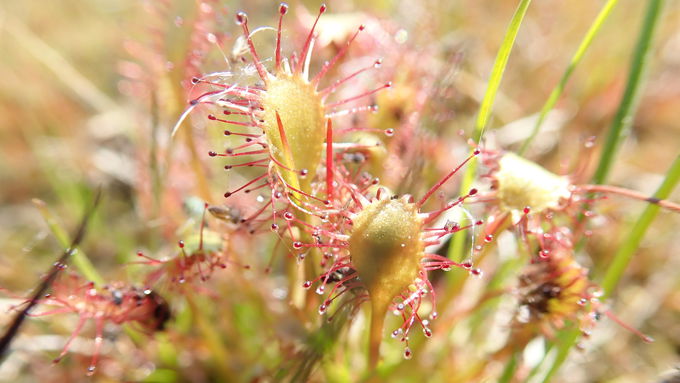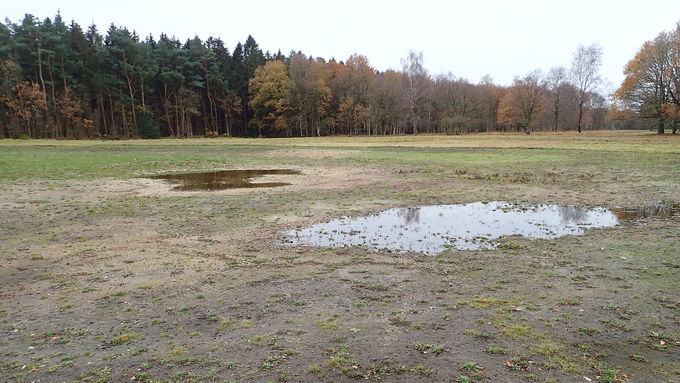Oblong-leaved sundew (Drosera intermedia) in the nature reserve ‘Schwarzes Meer’ © Thomas Kutter
main content
Project of the month
#3/2021
Development of nutrient-poor habitats in the nature reserve ‘Schwarzes Meer’
The nature reserve and SAC ‘Schwarzes Meer’ is located in the district of Wittmund in East Frisia and about 15 hectares in size. In its centre lies the lake with the same name, which is the only swale in this region. The area is owned by NABU Niedersachsen. ‘Ökologische NABU-Station Ostfriesland’ (ÖNSOF) is in charge of the area and is a project partner of the LIFE IP Atlantic Region DE.
The lake is originally a very nutrient-poor standing waterbody with oligotrophic waters containing very few minerals of sandy plains (Littorelletalia uniflorae, habitat type 3110) and transition mires and quaking bogs (habitat type 7140) which is surrounded by other nutrient-poor habitats such as species-rich Nardus grasslands (habitat type 6230) and heathland.
The nature reserve is home to endangered plant species such as the oblong-leaved sundew (Drosera intermedia), bog-rosemary (Andromeda polifolia), moonwort (Botrychium lunaria), heath violet (Viola canina), heath milkwort (Polygala serpyllifolia), and common trayblade (Listera ovata). The locust population includes Red List species such as the short-winged conehead (Conocephalus dorsalis), long-horned groundhopper (Tetrix tenuicornis), common green grasshopper (Omocestus viridulus), and lesser marsh grasshopper (Chorthippus albomarginatus). Remarkable butterflies are the grizzled skipper (Pyrgus malvae), the large chequered skipper (Heteropterus morpheus), and Zygaenid moths of the subfamily Procridinae.
The lake with its remarkable shoreweed occurrence has been exposed to various negative influences and threats for the last decades. After the closure of drainage facilities, the lake silted up. Input from leaves played a role in this, as did the floating of peat substrates and the development of peat mosses. The latter drifted in the main wind direction and deposited in the lakeside areas that used to be habitat for the shoreweed. The development of peat mosses was also accompanied by increasing acidification. It is suspected that the base buffer around ‘Schwarzes Meer’ may have been depleted. Acidification effects as a result of acid rain with the input of sulphuric acid could also play a role here. The shoreweed was last detected shortly after the turn of the millennium, later controls did not provide any more evidence.
In order to stop and reverse the negative developments in the waterbody, it was planned to be desludged within the framework of the LIFE IP. However, the exceptionally long period of drought in spring and summer 2018 prevented this action from being called for tenders. Due to the low rainfall, the waterbody had dried up for the first time in about 20 years, so that the opportunity arose to remove the sludge at low cost by dredging. The district of Wittmund spontaneously commissioned the desludging. More than 900 cubic metres of sludge were dumped at the edge of the lakeside and were later removed using funds from the LIFE IP.
However, the lack of openness of the waterbody due to surrounding tall woody plants was also held responsible for the disappearance of the shoreweed. This led to changed wind conditions and a calming of the wind; the bank dynamics were reduced. This can result in a higher carbon dioxide concentration in the water, which also contributes to acidification of the waterbody. Species-rich Nardus grasslands occurring in the nature reserve west of ‘Schwarzes Meer’ were also threatened by shading and foliage accumulation due to adjacent woody plants.
In order to preserve and develop both habitat types, the woody plants were removed from about 2.1 hectares of land spread across the nature reserve in January and February 2019. To promote amphibian and reptile hiding places, not all the woody material was removed, but several wood piles distributed throughout the area were created from metre-long pieces of logs.
In addition, the species-rich Nardus grassland occurrence was to be extended to the areas south of ‘Schwarzes Meer’. After a short period of agricultural use in the 1990s, the area had already been developed into extensively used, unfertilised grassland. A management and development concept prepared as early as 2000 recommended removing the humic topsoil. This idea was taken up again by ÖNSOF and the LIFE IP: The earthworks were carried out at the beginning of 2020. In addition to removing the topsoil, the sandy subsoil was also modelled so that a more varied relief was created which provides a habitat for species with different requirements for light and moisture. In this way, species-rich Nardus grasslands are to be developed and at the same time nutrient inputs into the lake are to be reduced.
An unexpected side effect is that the created terrain depressions hold rainwater remarkably well due to an underlying retaining layer. This may have created spawning grounds for the natterjack toad (Bufo calamita) which still occurs in the nearby area, and which will become apparent in the course of the coming spring. The species had already been reported for the area in the 1980s, but was recently only occasionally part of the native amphibian fauna.





